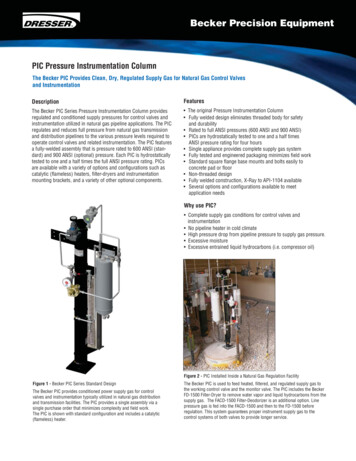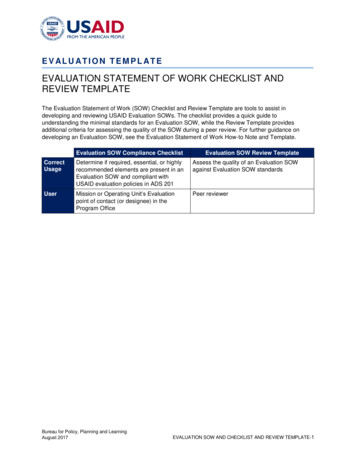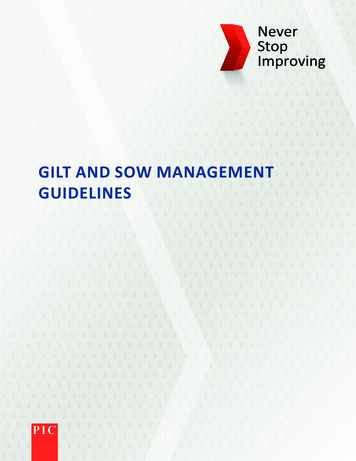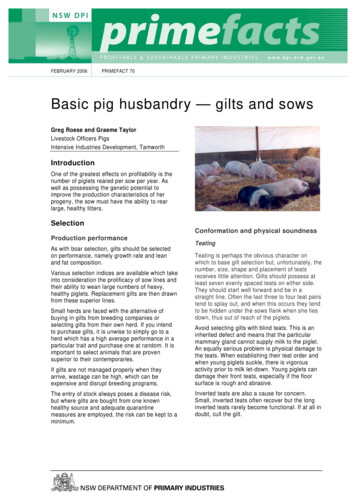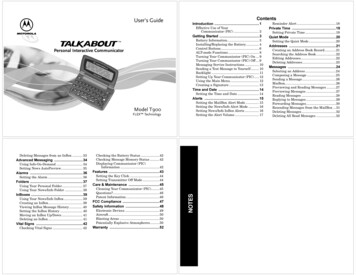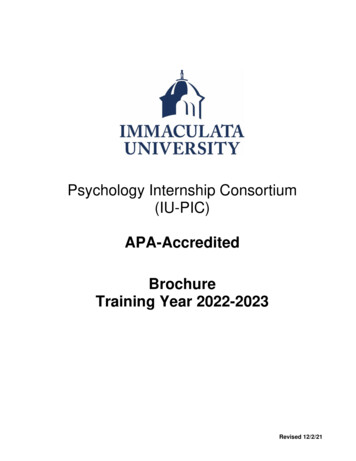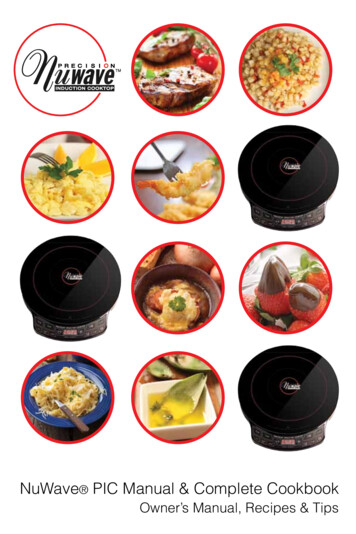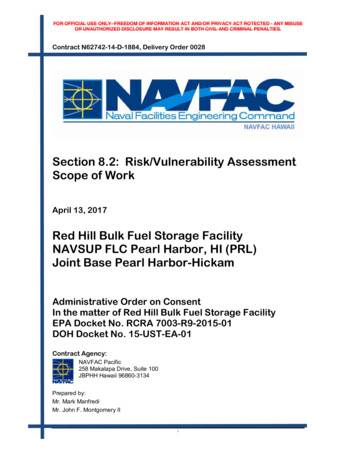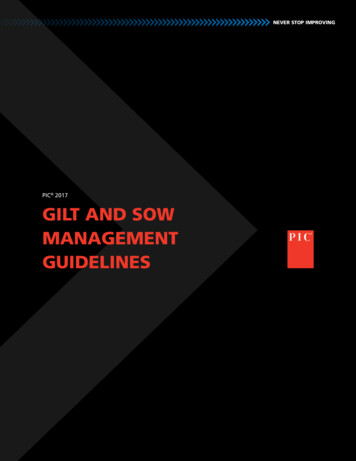
Transcription
NEVER STOP IMPROVINGPIC 2017GILT AND SOWMANAGEMENTGUIDELINES
WELCOME TO THE 2017 EDITIONOF THE PIC GILT AND SOWMANAGEMENT GUIDELINESWe are pleased to present the 2017 PIC Gilt and Sow Management Guidelines. These guidelinesare intended to provide recommendations for staff working at a commercial sow farm. In addition,these good management practices are also applicable to multipliers and production nucleus farms.Compared to the 2015 edition, we have simplified the search for information. The guidelines aredivided into seven sections that cover the different phases of production on a sow farm. Eachsection contains expectations, good management practices and advice for troubleshooting the mostcommon issues. In order to simplify and speed up the search for the information, we have made aserious effort to replace long texts by tables.The material has been reviewed by professionals and experts across the world to make it a globalreference. The focus is on the biology of the animals, independent of the geographical location, sizeof operation, sow:worker ratio, facilities set up or use of specific feed ingredients. The guidelinesfocus on production management and we have chosen to leave out biosecurity and health protocolsand acclimatization practices. We suggest you reach out to your herd veterinarian or our HealthAssurance team to develop a tailored program based on your circumstances. Last, but not least, wehave added separate sections for group housing and for batch farrowing.We recognize that there are different ways to achieve the desired results so these guidelines do notreject other management strategies.This document is intended to provide guidance and suggestions to our valued customers. At alltimes, please follow the best practices and appropriate standards with respect to animal welfare andhealth as outlined by the local governing body, within your country.
GLOSSARY OF TERMS & ACRONYMS. 1SECTION 1: GENERAL FARM REVIEWPROCESS REVIEW. 3PERFORMANCE REVIEW. 3FINANCIAL IMPACT OF KEY PERFORMANCE INDICATORS. 6FARM VISIT. 6SECTION 2: GILT MANAGEMENTELIGIBILITY FOR BREEDING. 7GOOD MANAGEMENT PRACTICES. 8GILT PRODUCTION FLOWS. 12SECTION 3: BREEDING & GESTATIONGOOD MANAGEMENT PRACTICES. 13POST CERVICAL ARTIFICIAL INSEMINATION (PCAI). 17PREGNANCY DIAGNOSIS. 18REPRODUCTIVE PERFORMANCE BELOW EXPECTATIONS. 18SECTION 4: GROUP HOUSINGFLOWS AND GROUP SIZE. 22ESF. 22TROUBLE-SHOOTING. 24SECTION 5: FARROWING MANAGEMENTGOOD MANAGEMENT PRACTICES. 25WEANING AGE/LACTATION LENGTH. 27TROUBLE-SHOOTING CHECKLISTS. 28SECTION 6: BATCH FARROWINGTYPE OF BATCHES. 30RECONVERTING FROM WEEKLY FLOW TO BATCH FARROWING. 30KEY POINTS. 31SECTION 7: PARITY STRUCTUREGOOD MANAGEMENT PRACTICES. 33GILT AVAILABILITY. 33GILT SELECTION. 33INDIVIDUAL SOW CARE. 33CULLING STRATEGY. 33TROUBLE SHOOTING HIGH SOW MORTALITY ANDLOW RETENTION RATE. 34NEVER STOP IMPROVING
GLOSSARY OF TERMS & ACRONYMSSECTION 1PICpro100An algorithm developed by PIC to remotely screen production processes, assigning then a score from 0 to 100.ParityFemale age based on how many farrowings they have. Thus, Parity 0 is gilt that has been bred but still hasnot farrowed; parity 1 is a female that has farrowed once before.Parity dipIt is when litter size drops from one parity to the next. Usually from parity 1 to parity 2.TargetThe numerical value of a goal.Intervention levelThe actual performance value that should trigger defined actions to break a performance trend and improve.Breed backPercentage of the weaned females that shows standing heat within a given period, usually 7 days.Piglet conversionPercentage of weaned pigs out of the total number of pigs born in a given period.Pigs weaned/sow/yearNumber of weaned pigs in a full year divided by the average inventory of mated females.Average age at removalAge of the sows, in number of parities, when the removal (death loss and culling) happens.SECTION 2Eligibility for breedingA set of characteristics that make a group of gilts ready to be bred with no negative long term repercussionsand optimized economics.First breedingThe first insemination that a female gets in its life.Lifetime performanceAverage number of weaned (or marketed) pigs until the female is culled or dead.NurseryUsually the phase from weaning to 11 weeks of age.GrowerUsually the phase from 11 weeks of age to 22 weeks of age.GDUIt stands for gilt developer unit. It is usually the phase from 22 weeks of age to 28 to 30 weeks of age.cfmIt stands for cubic feet per minute. It is an expression of the volume of air moving through a ventilation systemor other space.Breeding interval lengthTime elapsed from the moment the first female is bred until the moment when the last one is bred in the day.AI/AOIt stands for all in-all out. It refers to the way a room or an entire building is loaded and emptied.NEVER STOP IMPROVING1
SECTION 3Meishan crossesAny individual containing blood from Meishan genotypes. They are broadly utilized as heat detection boars.FosteringAction to relocate individual piglets to another sow to give them more chances to nurse.SECTION 4Pre-implantationFlow where sows are moved to groups in early gestation, usually within 4 days after breeding.Post-implantationFlow where sows are usually moved to groups after spending the first 4 weeks of gestation in individual spaces.StaticThe group is constituted at once, social hierarchy stabilizes and the group is left intact for the durationof gestation.DynamicThe group is constantly changing by 15 to 20% of the individuals. Essentially it is a continuous flow systemthat looks to optimize space utilization.Catabolic periodA time where body weight is lost, due to lack of enough feed intake or diets that don’t meet the requirednutrient specifications for the age/weight/physiological status.SECTION 5Split-suckleA practice to separate part of the litter for a defined period, to allow the remaining piglets full access tothe udder, with no competition.Runt littersLitters created by placing small but viable piglets on a good nursing sow.Parity structureThe combination of the different ages of the sow census.PWMIt stands for preweaning mortalityRuntSmall but viable pigletSECTION 6Late weanersSows that don’t show signs of estrus 7 days after weaning and beyond.Non-productive daysDays where the sow is either not gestating nor lactating.2
Section 1:GENERAL FARM REVIEWThis section provides checklists on key performance indicatorsrelated to general sow farm processes and performance.Comparing actual values versus target levels will help sowfarm managers identify improvement opportunities to get themost value out of their operations. It will also indicate the needfor intervention.PROCESS REVIEWIt is essential to understand the processes that could potentially limit the expression of the geneticpotential. PIC has developed the PICpro100 tool to objectively assess a producer’s production practices.PICpro100 uses an algorithm developed by PIC that assign a score to 23 production practices mostassociated with high sow herd performance by comparing them against accepted good managementpractices. PICpro100 can be used to complement more traditional methods to review and evaluate sowherd performance. The PIC Technical Services Team or your PIC Account Manager can help you gainadditional exposure to this tool.PERFORMANCE REVIEWIn addition to reviewing production processes, it is important to review performance records by parityand over a period of minimum 13 weeks. Key indicators to watch are farrowing rate, litter size,pre-weaning mortality, sow mortality, breeds per week and how many weeks are off target,replacement rate, wean to service interval, presence of parity dip and number of doses per sow in estrus.Many other indicators can be reviewed but the first screening will suggest which indicators to reviewand/or what to watch for during a farm visit.NEVER STOP IMPROVING1-1
TABLE 1.1: GILT MANAGEMENT PROGRAM TARGETSKEY PERFORMANCE INDICATORMortality 3 to 25 weeks of ageSelection at 25 weeks of ageTARGETINTERVENTION LEVEL 3% 5%70 to 80% 65% and 90%Percentage of gilts bred at/after 2nd estrus 95% 90%Recorded estrus on week 4 after beginning ofboar exposure at 24-26 weeks of age 70% 50%Parity 1 farrowing rate 93% 90% 15.5 total born 14.5 born alive 13.5 pigs weaned 14.5 total born 13.5 born alive 12.5 pigs weaned 90% 85% 6 days 7 days 95 parity 1 85 parity 2 75 parity 3 85 parity 1 75 parity 2 65 parity 3Parity 1 litter sizeParity 1 breed backParity 1 wean to service intervalRetention rates (starting with 100 bred gilts)TABLE 1.2: ENTIRE FARM TARGETSKEY PERFORMANCE INDICATORLactation LengthINTERVENTIONLEVELTARGET21 days28 daysFarrowing Rate 92% 90% 92% 90%Litters/Sow/Year 2.50 2.45 2.40 2.35Avg Total Born 16.0 15.0 16.3 15.0Avg Born Alive 15.0 13.8 15.3 13.8Avg Weaned 14.0 12.5 14.3 12.5Piglet Conversion 88% 83% 88% 83%Breed-back 92% 88% 93% 89%Avg Wean to Service Interval1-2INTERVENTIONLEVELTARGET 5.5 days 7.0 days 5.0 days 7.0 daysAnnual Sow Mortality 5% 8% 5% 8%Pigs Weaned/Sow/Year 35.0 30.6 34.2 29.4Pigs Weaned/Farrowing Space/Year 212 185 167 144Pigs Weaned per Lifetime 67 59 66 56
TABLE 1.3: SPECIFIC REPRODUCTIVE TARGETSKEY PERFORMANCE INDICATORTARGETINTERVENTION LEVEL 5% 10%Breeding group variation, % above or below target# of weeks off breeding target within last 13 weeks 2 3Conception rate 97% 92%Total return rate (includes regular, non-regularand late returns), as % of the breeds 5.0% 10% 1% 3%Not-in-pig sows, as % of the breeds 0.5% 1%Vaginal discharge, as % of the breeds 0.5% 1% 1% 3%Annual gestation feed usage per sow700 – 750 kg 770 kg and 680 kgFeed usage in wean to service interval 23 kg( 20 kg in Parity 1) 16 kg( 13.5 kg in Parity 1)Sows in ideal body condition by day 30 of gestation,as % of the group 85% 80%Sows in ideal body condition going to farrowing,as % of the group 90% 85%Abort rate, as % of the breedsOther reproductive failure (including dead anddestroyed while pregnant), as % of the breedsTABLE 1.4: SPECIFIC FARROWING TARGETSKEY PERFORMANCE INDICATORBirth WeightPre-weaning mortalityTARGETINTERVENTION LEVEL 1.35 kg/pig 1.1 kg/pig 10% 12%Avg piglet weaning weightKg weaned/Sow/Year at 21-22 days of age 6 kg/pig 205 kg/sow/year 5.5 kg/pig 168 kg/sow/yearAvg piglet weaning weightKg weaned/Sow/Year at 28 days of age 7.25 kg/pig 248 kg/sow/year 6.5 kg/pig 193 kg/sow/year5% 10%Nurse sows, as % of the weekly farrowingsTABLE 1.5: KEY INDICATORS ASSOCIATED TO PARITY STRUCTURE ON A COMMERCIAL FARMPIC TARGETSINTERVENTION LEVELAnnual replacement rateKEY PERFORMANCE INDICATOR45 - 55% 40%; 60%Culling rate40 - 50% 55% 5%, 3%, 2% 9%, 6%, 4%Avg herd ageParity 3.5 Parity 3.0; Parity 4.0Avg age at removalSow mortality, death rate, euthanized Parity 5 Parity 4.5; Parity 6.3Gilt utilization up to parity 1(% of gilts farrowed out of arrivedgilts with 20 weeks of age) 95% 90%Gilt utilization up to parity 2 85% 75%Gilt utilization up to parity 3 75% 65%Gilt utilization up to parity 6 55% 45%NEVER STOP IMPROVING1-3
FINANCIAL IMPACT OF KEY PERFORMANCE INDICATORSIn addition to reviewing the production KPIs, we encourage the review of financials associated with thesetargets and any proposed management changes. This will help to understand where to prioritize effortsand deploy resources when attempting to address indicators that are not up to the expectations.FARM VISITThe ultimate farm review is an in-person visit. It will help to confirm or rule out what is suspected fromthe records and remote review of the processes. It is also important to check that sick animals are timelytreated and to discuss with the farm manager any concern about animal well-being.TABLE 1.6: SIGNS/SYMPTOMS TO WATCH WHEN VISITING A SOW FARMKEY s all feedOff-feed, feed refusalBody conditionAble to maintain itWeight lossStand upWon’t stand up;Apathetic or lethargicBearing weight evenly on all four legsLamenessShort and smooth hair;Pink skinLong or rough hair;Yellow, pale, red orblue skinAble to maintain pregnancy;Mammary gland developmentAbortion;No mammary gland developmentNormal: up to 38.5 Cin gestation;Up to 40 C while farrowingFever: 38.5 Cin gestation; 40 C the dayafter farrowingNormal frequency:13-20/minCoughing;Abnormal respiratory frequencyFecesManure is softScours;ConstipationUrineLong and strongurine streamShort urine;White urineResponse to stimulusSoundness and structureSkin and coverPregnancyBody temperatureRespiratory1-4
Section 2:GILT MANAGEMENTThis section provides recommendations and best practices forgilt management. It will help producers prepare gilts to havehigh performance in their first parity while priming them forhigh lifetime performance.ELIGIBILITY FOR BREEDINGPart of the variation in performance across systems and even within systems can be attributed to thequantity and quality of gilts at their first breeding. The conditions associated with high performance inparity 1, such as lifetime performance and optimized cost of production, are summarized in the tablesbelow.TABLE 2.1: GILT ELIGIBILITY REQUIREMENTSTRAITBody weightAverage daily gain from birth to first breedingTARGET 90% of gilts bred within the 135 to 160 kg range600 to 770 gram/day and 90% of gilts breed within the rangeImmunity level3 effective weeks from last health procedureAgeFrom 29 weeks of age (203 days),if meeting the conditions mentioned aboveNEVER STOP IMPROVING2-1
GOOD MANAGEMENT PRACTICESUnder all circumstances, producers should adhere to the locally applicable laws that regulatemanagement and housing practices, even if they differ from the recommendations presented inthese guidelines.TABLE 2.2: GENERAL HOUSING RECOMMENDATIONS(For additional information please refer to the PIC Wean-to-Market Production Manual)MANAGEMENTFACTORRoom temperatureNURSERYGROWERGDUIt depends onweaning age,flooring and use of mats;to be on the safe side,consider roomtemperature at 26.5 C21 C19 CMinimum ventilation(cold): 2-5 cfm/head;Mild: 15 cfm/head;Maximum ventilation:40 cfm/headMinimum ventilation(cold): 5-10 cfm/head;Mild: 35-50 cfm/head;Maximum ventilation:120 cfm/headMinimum ventilation(cold): 12 cfm/head;Mild: 60 cfm/head;Maximum ventilation:150 cfm/headVentilationHumidityStocking densityFlooring65% 0.33 m /head 0.70 m2/head2 1.11 m2/headPlastic floors only to end of nursery phase;Slatted floors: 2.5 cm or less opening, with straight edges;Solid floors: sloped to avoid manure and liquid build-up;Use bedding material when its use is mandatory by lawTABLE 2.3: GENERAL FEEDING RECOMMENDATIONSMANAGEMENT FACTORGROWERGDUWater sourcesClean and fresh always available;1 water source per every 10 gilts;When using fixed nipple drinkers, leveled to the height of theshoulder of the smallest giltsVolumetric water flow rate 1 L/minDietsFeeder and feeders spaceFeeding strategy2-2NURSERY 1.5 L/min 2 L/minSpecific for age/weight;Use PIC Nutritional Manual for more informationDry feeders;2.5 cm linear space/present giltWet/dry feeders;5 cm linear space/present giltFull feed;Avoid feed disruptions/feed outages
TABLE 2.4: PRELIMINARY GILT SELECTION RECOMMENDATIONS(For a detailed description of the selection process refer to the PIC Selection Manual)TRAITProcessGoalThrifty, unsoundness, fallingbehind, sickness, joint issuesHooves issuesTeatsNURSERYGROWERNot a routineThorough selection beforetransfer to GDUAvoid sending gilts to nursery withevident issues and/or defectsAvoid sending gilts to GDU withevident issues and/or defectsDo not selectDo not selectUsually unseen at this phaseDo not select gilts showing clubfoot, uneven toes, long dew clawsToo soon to evaluateIf counted, do not selectwith less than 14 potentiallyfunctional teatsTABLE 2.5: MANDATORY GILT SELECTION RECOMMENDATIONS(For a detailed description of the selection process refer to the PIC Selection Manual)TRAITProcessGDULast opportunity to perform quality controlThrifty, unsoundness, falling behind,sickness, joint issue, gaunt.Do not selectDo not select gilts showing club foot,uneven toes, long dew clawsHooves issuesTeatsMust be carefully counted;Do not select with less than14 potentially functional teatsHeatsDefine a protocol to deal with non-cyclersif that are truly gilts not showing estrusTABLE 2.6: BOAR EXPOSURE AND HEAT DETECTION RECOMMENDATIONSTRAITGDUStarts at24-26 weeks of ageStrategy1x daily; 7 days a week; early in the morning;Nose to nose contact, with boar inside the gilt pen orin BEAR(*),15 minutes maximum per every 20-30 gilts;Never leave this job to the end of the dayEstimation of time needed120 minutes/1 person/1 boar per 2,500 sows on daily basisRatio of adult boars to giltto be boar exposed1 adult boar per every 100 gilts;Avoid working boars longer than 60 minutes;Replace 30-40% of the boars per year(*): BEAR stands for boar exposure area. Source: Designing effective boar stimulation systems as a criticalfeature of the Gilt Development Unit. E. Beltranena, J. Patterson and G. Foxcroft. Leman Pre-ConferenceReproduction Workshop Effective Management of Replacement Gilts (2005)NEVER STOP IMPROVING2-3
TABLE 2.7: RECOMMENDATIONS TO ADDRESS LOW PERCENTAGE OF GILTS IN HEATPoints to review and interventions when finding a low percentage of gilts with reported estrusPOTENTIAL CAUSESHot weatherINTERVENTIONS Annual service of the ventilation equipments and controls;Clean up fan blades and replace broken ones on an as-needed basis;Clean feeders up to avoid moldy/spoiled feed build up;Review fresh water availability;Plan to maintain man-power during holidays and vacations;Heat detection performed in the earliest/coolest part of theworking dayLimited feed intake Severe restrictions can delay the group’s beginning of estrus; Check feeder space per gilt; Quantify the real needs of gilts as on over-flow of gilts could limit theireasy access to the feed; If gilts are restricted because they are too heavy, a review of the flow isneeded and perhaps early breeding is advisable; Rule out mycotoxins in feedLow boar power Check if there are enough number of mature boars to perform bothboar exposure and heat detection; Avoid working the boars continuously for longer than 1 hour; Over-worked/tired and/or too heavy boars don’t do a good job; Be aware that continuous exposure to the same boar(s) can also beassociated with a poor gilt response 2-4Low man powerCheck effective man-hours spent on boar exposure and heat detection;Check weekend/holidays/vacation staffing;Labor qualification and expertise;If approved by regulatory entities, pharmacological interventionscan be the last resource and diagnostic. Ask your herd veterinarian whenit is advisable to consider these as an option; Slaughter checks of the ovaries. Non-cycling ovaries are smoothstructures while active show follicles and corpus luteum development; A P4 test can identify true vs. untrue anoestrus but it is notrecommended for routine utilization. Also ask your herd veterinarianfor advise.Exacerbated and/orcontinuous stress Avoid/mitigate stressor: gilts need water, feed, and to feel no fearHealth and health procedures Negative impact of major health challenges at an early phaseof gilt development; Avoid vaccinations in the last 3 weeks prior to the first breeding
TABLE 2.8: RECOMMENDATIONS TO ADDRESS LOW LITTER SIZE AND/ORLOW FARROWING RATE IN GILTSPoints to review and interventions to improve reproductive resultsPOTENTIAL CAUSESINTERVENTIONSHot weather Check Table 2.7Limited feed intake Feed restriction 15 days prior breeding can hinder litter sizeLimited boar powerLow man power Check Table 2.7Exacerbated and/or continuous stress Check Table 2.7; Manage animal flow when there is a lack of parity segregationin group housing settingsHealth procedures Avoid vaccinations in first 4 weeks of gestation; Review selection criteria and process of selection when lamenessis seen in recently bred Parity 0 animals; After stocking new farms, new and abrasive floor cancreate hooves and sole issues; Avoid breed animals that need individual treatments aroundthe breeding and early gestation; If that happens, review the reasons and address them and alsoconsider a more aggressive culling strategyProduction flow Avoid mixing and/or any stressful management fromday 3 to day 28 after breedingBreeding interval length The shorter the better without compromising quality of theindividual services, especially during hot weatherSemen quality Check with your supplier on any event that can be associatedwith poor performance; Check semen storage units and temperature logs; Eliminate any doses carried back from the breeding barn tothe refrigeratorNEVER STOP IMPROVING2-5
GILT PRODUCTION FLOWSThere is no consensus on what is the best flow to generate replacement gilts as each possibility haspros and cons and depends on the local circumstances. Different options are shown below.TABLE 2.9: MOST COMMON GILT FLOWSGILT SOURCEEXTERNALCONTINUOUS FLOWImplementation & executionof genetic program Oversizedmultiplication insmaller farms Gilt flow control Acclimatization to sow herd Advantage in cleanenvironmentsAdvantagein challengedenvironments(allow exposuremanagement)Advantage in cleanenvironments Good in controlPRRS/PED Same as sow herdHard to control/eliminate diseasesGilt usage rate & performanceBiosecurity concerns HigherTransport costsDedicated laborBuilding costsAbility to match diets to weights NoneSystem choice should not be decisiveLabor cost efficiency Depends on volume. Need ISO & Testing Lower Key: unfavorable; less favorable; highly favorable2-6INTERNALAI/AO
Section 3:BREEDING & GESTATIONThis section provides recommendations to realize superiorreproductive performance. It also provides best practices onaccomplishing a precise weekly breeding target which will helpto establish a consistent pig flow downstream.GOOD MANAGEMENT PRACTICESProducers must follow local and national regulations at any time and place. When regulation allows,consider the following recommendations.TABLE 3.1: HOUSING ECOMMENDATION18 – 20 CMinimum ventilation (cold): 12 cfm/headMaximum ventilation: 150 cfm/head 65%NEVER STOP IMPROVING3-1
TABLE 3.2: WEANED SOWS MANAGEMENT RECOMMENDATIONPROCESSRECOMMENDATIONCulling Identify and mark cull sows in farrowing andavoid housing them with weaned sowsMovements Identify and mark sows that will need treatment after weaning;Wean early in the morning and transfer weaned sowsto the wean area on the same day Maintain an organized wean area and identify late weaners by weekly lots;Group all late weaners together in a specific area in the breeding barn;If enough replacements are available consider culling every parity 3 andolder that has not cycled after day 7 post-weaning;Provide 16 hours of photoperiod and 250 lux (never fewer than 200 lux).Empirical experience suggests to have 150W light sources every 1.5 m linear;If approved by law, pharmaceutical intervention can be used to supportthe production flow in critical seasons and get sows back to estrus in case ofdelays (always consult your herd veterinarian for details)General strategy Feeding Review Table 3.4TABLE 3.3: RECOMMENDATIONS TO CONSISTENTLY ACHIEVE BREEDING TARGET INTEGRITYCOMPONENTSWeekly variationsParity structure3-2RECOMMENDATION Avoid any disruption in your weekly gilt flow availability;Maximum 5% over/under weekly breeding target to1. keep your breeding flow consistent;2. keep your weaning flow consistent;3. minimize weaning age variation Only breed sows that are eligible to farrow and wean healthy piglets;Do not breed lame or sick sows;If enough replacements are available to preserve the breeding target,consider culling what is presented in Section 7 of these guidelines;Try to solve reproductive issues by adjusting management strategies first.If approved by law, pharmaceutical intervention can be used to supportthe production flow on critical seasons and get sows back to estrus in caseof delays (consult your herd veterinarian for details)
TABLE 3.4: GENERAL FEEDING RECOMMENDATIONSCOMPONENTSWater availabilityDietRECOMMENDATION Feeding strategy Body conditionassessment Body weight dynamic Full availability and easy access;1 water source per 10 sows and 1.9 L flow per minute in group housingFor further information refer to the PIC Nutrient Specifications Manual 20163 Phases:1. full feed on wean to service interval;2. restricted feed based on body condition during gestation;3. bump feed in late gestation for parity 0, only if body condition isnormal or thin;Group gilts and sows according to body condition assessment in grouphousing to facilitate feeding management;For further information refer to the PIC Nutrient Specifications Manual 2016Goal is to have 85% of the females in an ideal body condition rangeby 28-35 days of gestation and 90% going to farrowing;The use of both body condition assessment systems (caliper and visualassessment) coupled with quarterly feed usage and performance datais preferred;Ideal body condition with visual assessment means that the back, hip, andrib bones cannot be seen but can be felt when touching the sowwith slight pressure;Ideal condition with caliper assessment is between 12 to 15 units range;Annualized gestation feed usage should be within 680 and 770 kg.An investigation is needed when the farm is above or below that range;Annual sow mortality within below 9%;Perform body condition assessment at weaning;Perform body condition assessment at 30 days, 60 days and 90 daysof gestation;For individually housed facilities: two people are needed: one at the back ofthe sows who assesses body condition, the other one at the front adjusts thefeeding boxes according to the nutritionist s recommendation;For further information refer to the PIC Nutrient Specifications Manual 2016Not more than 45 kg of net body weight gain at parity 0;Not more than 23 kg of net body weight gain from parity 1 and onwardsNEVER STOP IMPROVING3-3
TABLE 3.5: SEMEN DOSES MANAGEMENT RECOMMENDATIONSCOMPONENTStorage capacityRECOMMENDATION Semen storage device should be sized for weekly delivery;Storage capacity equivalent to 0.6 L per dose;Batch farrowing systems might require more storage capacity thancontinuous flows;Two small storage devices instead of one big can mitigate the risk oftechnical failures;To improve safety, have surge protectors and battery backups in placeSpace cooler – wall Storage devicesmaintenance Once a year; preferable prior to summer 16 – 18 C;Record maximum and minimum temperature daily Take doses to the breeding barn in an insulated container with gel packsto maintain temperature;Have enough doses for maximum 1 hour of breeding;One way road, no doses from breeding barn back to the refrigeratorTemperatureStorage temperatureFluctuationDeliveriesHandlingSemen ageTransport to breedingand gestation barn 2.5 cm 1 C;Every fluctuation 1 C can reduce semen dose shelf life up to 1 day2x per week as minimum and 3x a week as optimumStore doses loose, unpacked, and horizontal;First in - first out principle: use oldest doses first;Rotate semen doses once a dayOptimum: 3 days age (from semen collection);Plan semen orders accordingly;Every additional day of semen age can reduce total bornby 0.3 pigs per farrowingTABLE 3.6: BOAR EXPOSURE AND HEAT DETECTION RECOMMENDATIONSCOMPONENTBoar to sow ratioBoar ageAnnual boar replacementBoar qualityHeat checking3-4RECOMMENDATION 1:200 Frequency: 1x daily; 7 days a week;Order: Gilts - weaned sows - 21 day bred group - opportunity sows;Allow nose-to-nose contact 11-12 month;Meishan crosses 5-6 month30-40% (30% when using Meishan crosses)Use active, smelly boars with good salivation andoptimum body condition
TABLE 3.7: BREEDING RECOMMENDATIONS (CONVENTIONAL)PROCESSRECOMMENDATIONQuality of female at b
An algorithm developed by PIC to remotely screen production processes, assigning then a score from 0 to 100. Parity Female age based on how many farrowings they have. Thus, Parity 0 is gilt that has been bred but still has not farrowed; parity 1 is a female that has farrowed once before. Parity dip
